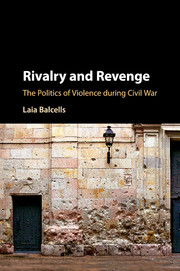Book contents
- Frontmatter
- Dedication
- Contents
- List of Figures
- Acknowledgments
- Conventions
- Preface
- PART I
- PART II
- 3 History of the Spanish Civil War (1936–1939)
- 4 Executions and Massacres During the Spanish Civil War
- 5 Bombardments During the Spanish Civil War
- PART III
- Appendix
- Bibliography
- Index
- Miscellaneous Endmatter
3 - History of the Spanish Civil War (1936–1939)
from PART II
Published online by Cambridge University Press: 18 May 2017
- Frontmatter
- Dedication
- Contents
- List of Figures
- Acknowledgments
- Conventions
- Preface
- PART I
- PART II
- 3 History of the Spanish Civil War (1936–1939)
- 4 Executions and Massacres During the Spanish Civil War
- 5 Bombardments During the Spanish Civil War
- PART III
- Appendix
- Bibliography
- Index
- Miscellaneous Endmatter
Summary
INTRODUCTION
The empirical evidence in this book is largely based on the Spanish Civil War, which started on July 18, 1936 and came to an end on April 1, 1939. This chapter will introduce this civil war to the reader in a synoptic way. The goal is to historically and geographically contextualize the empirical evidence that I will analyze in Chapters 4 and 5. This chapter describes the circumstances preceding the outbreak of the civil war and the dynamics of the conflict as it developed. It also briefly outlines the specific wartime histories of different regions that I will later analyze (e.g., Aragon, Catalonia, Malaga) and it explains how these territories resemble the remaining areas of Spain, where findings should be generalizable. The chapter puts forward the idea that the micro-dynamics of violence on either side of the conflict were not fundamentally different. Indeed, the qualitative evidence from this civil war suggests that, despite the striking differences in ideology and organizational structure between loyalists and rebels, there are important commonalities in the dynamics of violence that took place in their respective rearguard territories, which were driven by local-level interactions between political elites and armed actors.
The Spanish Civil War started with a military coup carried out by a rebel military faction against a legally constituted democratic government. It lasted for almost three years and it caused around 600,000 deaths, including combatants and civilians (Casanova 2014), and over 440,000 externally displaced (Rubio 1977). According to the most current data, the total number of civilian deaths in the areas under Loyalist (i.e., Republican) control was 49,272; the total number of civilian deaths in the Rebel (i.e., Nationalist) areas is still unknown, but is estimated to be around 150,000 (Preston 2011: 22–24).
The Spanish civil war was a conflict between two main politico-military blocs: 1) The army of the incumbent government (Republicans or Loyalists), which also included militias of political parties (e.g., POUM – Troskist communist party, FAI – anarchist, PC – communist), trade unions (e.g., CNT – anarchist, UGT. – socialist), and the International Brigades. I include them under the label of the Left. 2) The rebel army (Francoists or Nationalists), which included splinter factions from the regular army, legionnaires, and various militias (e.g., Falangists, Carlists, Requetés).
- Type
- Chapter
- Information
- Rivalry and RevengeThe Politics of Violence during Civil War, pp. 49 - 86Publisher: Cambridge University PressPrint publication year: 2017

